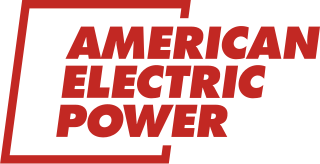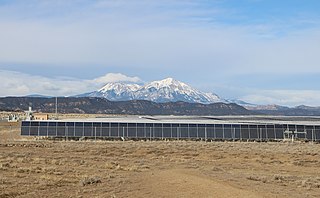
Southern California Edison (SCE), the largest subsidiary of Edison International, is the primary electric utility company for much of Southern California. It provides 15 million people with electricity across a service territory of approximately 50,000 square miles.
A worker cooperative is a cooperative owned and self-managed by its workers. This control may mean a firm where every worker-owner participates in decision-making in a democratic fashion, or it may refer to one in which management is elected by every worker-owner who each have one vote. Worker cooperatives may also be referred to as labor-managed firms.

American Electric Power Company, Inc. (AEP), is an American domestic electric utility company in the United States. It is one of the largest electric utility companies in the country, with more than five million customers in 11 states.

Duke Energy Corporation is an American electric power and natural gas holding company headquartered in Charlotte, North Carolina. The company ranked as the 141st largest company in the United States in 2024 – its highest-ever placement on the Fortune 500 list.

Ted Howard is a political activist and author. He is the founder and Executive Director of The Democracy Collaborative, as well as chairman of the board of ocean advocacy group Blue Frontier Campaign. He was the Minter Senior Fellow for Social Justice with the Cleveland Foundation from 2010-2014.

FirstEnergy Corp. is a privately owned electric utility headquartered in Akron, Ohio. It was established when Ohio Edison merged with Centerior Energy in 1997. Its subsidiaries and affiliates are involved in the distribution, transmission, and generation of electricity, as well as energy management and other energy-related services. Its ten electric utility operating companies comprise one of the United States' largest investor-owned utilities, based on serving 6 million customers within a 65,000-square-mile (170,000 km2) area of Ohio, Pennsylvania, West Virginia, Virginia, Maryland, New Jersey, and New York. Its generation subsidiaries control more than 16,000 megawatts of capacity, and its distribution lines span over 194,000 miles. In 2018, FirstEnergy ranked 219 on the Fortune 500 list of the largest public corporations in the United States by revenue.

Gar Alperovitz is an American historian and political economist. Alperovitz served as a fellow of King's College, Cambridge; a founding fellow of the Harvard Institute of Politics; a founding Fellow at the Institute for Policy Studies; a guest scholar at the Brookings Institution; and the Lionel R. Bauman Professor of Political Economy at the University of Maryland Department of Government and Politics from 1999 to 2015. He also served as a legislative director in the US House of Representatives and the US Senate and as a special assistant in the US Department of State. Alperovitz is a distinguished lecturer with the American Historical Society, co-founded the Democracy Collaborative and co-chairs its Next System Project with James Gustav Speth.

The economy of Ohio nominally would be the 20th largest global economy according to The World Bank as of 2022. The state had a GDP of $822.67 billion in 2022, which is 3.23% of the United States total, ranking 7th in the nation behind Pennsylvania and ahead of Georgia. In 2013, Ohio was ranked in the top ten states for best business climate by Site Selection magazine, based on a business-activity database. The state was edged out only by Texas and Nebraska for the 2013 Governor's Cup award from the magazine, based on business growth and economic development.

SolarCity Corporation was a publicly traded company headquartered in Fremont, California, that sold and installed solar energy generation systems as well as other related products and services to residential, commercial, and industrial customers. The company was founded on July 4, 2006, by Peter and Lyndon Rive, the cousins of SpaceX and Tesla CEO Elon Musk. Tesla acquired SolarCity in 2016, at a cost of approximately US$2.6 billion and reorganized its solar business into Tesla Energy.

Renewable energy in Canada represented 17.3% of the Total Energy Supply (TES) in 2020, following natural gas at 39.1% and oil at 32.7% of the TES.

As of 2019, renewable energy in Morocco covered 35% of the country’s electricity needs.

A community solar project, farm or garden is a solar power installation that accepts capital from and provides output credit and tax benefits to multiple customers, including individuals, businesses, nonprofits, and other investors. Participants typically invest in or subscribe to a certain kW capacity or kWh generation of remote electrical production. The project's power output is credited to investors or subscribers in proportion to their investment, with adjustments to reflect ongoing changes in capacity, technology, costs and electricity rates. Community solar provides direct access to the renewable energy to customers who cannot install it themselves. Companies, cooperatives, governments or non-profits operate the systems.

The energy sector of Ohio consists of thousands of companies and cities representing the oil, natural gas, coal, solar, wind energy, fuel cell, biofuel, geothermal, hydroelectric, and other related industries. Oil and natural gas accounts for $3.1 billion annually in sales while ethanol generates $750 million. Toledo is a national hub in solar cell manufacturing, and the state has significant production of fuel cells. In 2008, the state led the country in alternative energy manufacturing according to Site Selection Magazine, while the natural gas industry has experienced growth due to the expansion of shale gas.
The 12 megawatt (MW) Wyandot Solar Facility is a solar photovoltaic power plant completed in 2010, located in Salem Township, Wyandot County, Ohio. This system uses 159,200 panels spread over 83.9 acres (34.0 ha).

Solar power in Ohio has been increasing, as the cost of photovoltaics has decreased. Ohio installed 10 MW of solar in 2015. Ohio adopted a net metering rule which allows any customer generating up to 25 kW to use net metering, with the kilowatt hour surplus rolled over each month, and paid by the utility once a year at the generation rate upon request. For hospitals there is no limit on size, but two meters are required, one for generation, the other for utility supplied power.

The U.S. state of Utah has the solar potential to provide all of the electricity used in the United States. Utah is one of the seven states with the best potential for solar power, along with California, Nevada, Arizona, New Mexico, Colorado, and Texas. Utah's only investor owned utility currently allows partial net metering for residential systems up to 25 kW and up to 2 MW for non-residential users. In the past RMP allowed full net metering, and partial net metering. Neither of these Schedules allows for new customers to sign up any longer. Utah's municipal utilities and electric cooperatives set their own net metering policies.
The Cuyahoga Metropolitan Housing Authority (CMHA) is a governmental organization responsible for the ownership and management of low-income housing property in Cuyahoga County, Ohio. The organization was founded in 1933, making it the first housing authority in the United States.
The United States state of Arkansas is a significant producer of natural gas and a minor producer of petroleum.
Workplace democracy is the application of democracy in various forms to the workplace, such as voting systems, debates, democratic structuring, due process, adversarial process, and systems of appeal. It can be implemented in a variety of ways, depending on the size, culture, and other variables of an organization.

The San Isabel Solar Energy Center is a 30 megawatt (MWAC) photovoltaic power station in Las Animas County, Colorado located about 20 miles north of the city of Trinidad. The electricity is being sold to Tri-State Generation and Transmission under a 25-year power purchase agreement. It is the second solar project, following the Cimarron Solar Facility in year 2010, to be added to the utility cooperative's renewables portfolio.














